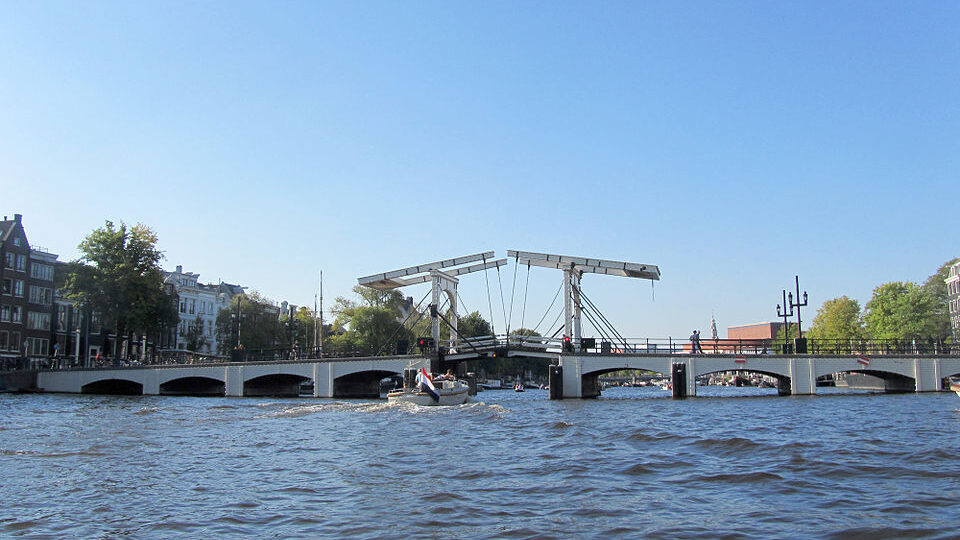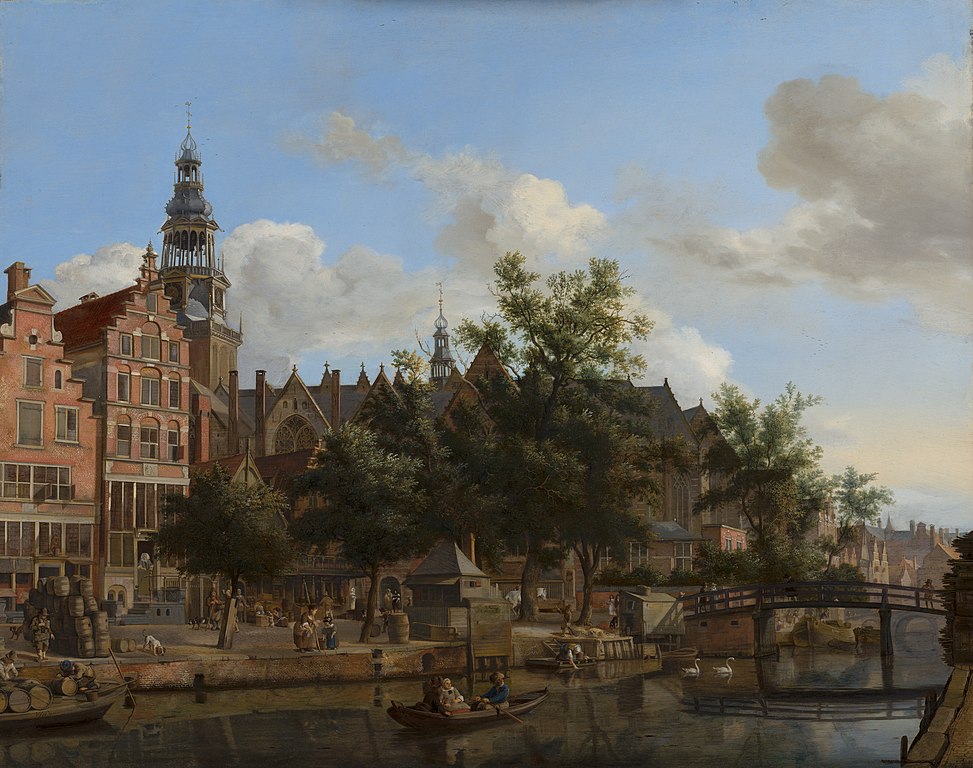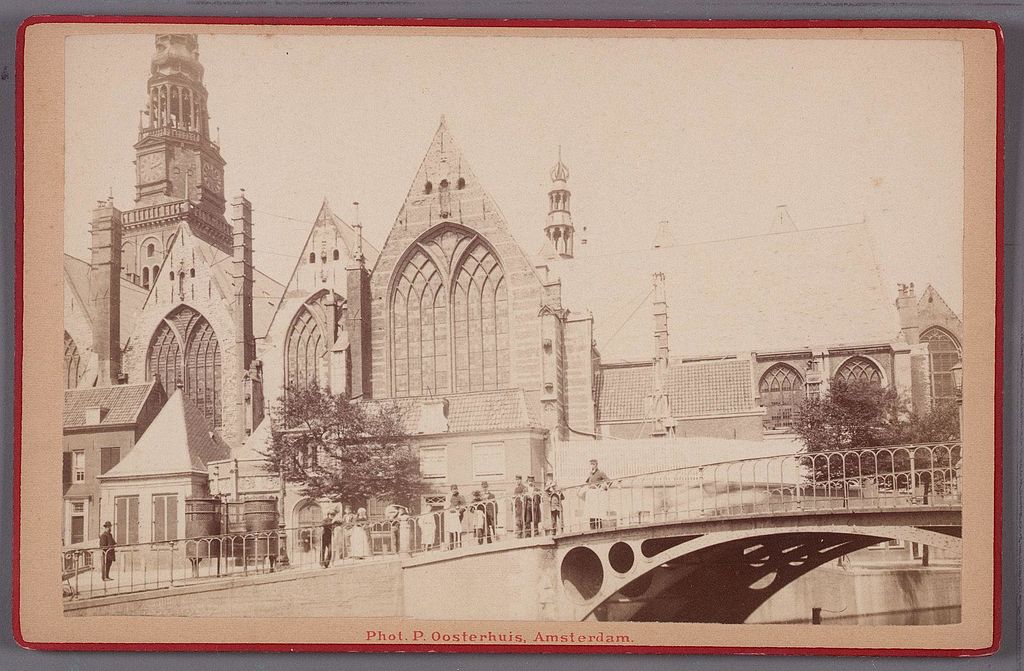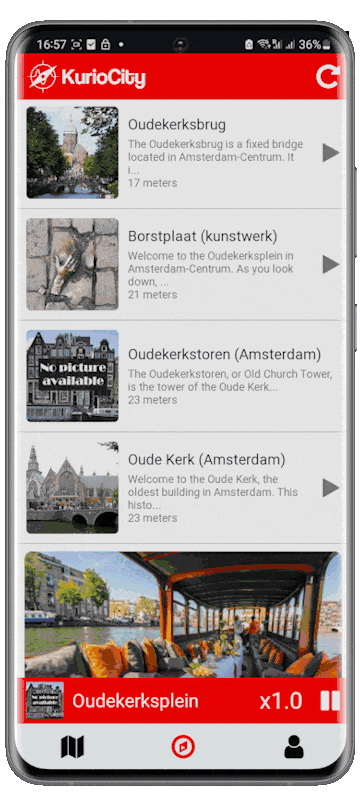How many bridges are there in Amsterdam?
This question is more complicated than it initially may seem. The short answer is that there are at least 2,156 bridges, 980 of which have an official name. However, those numbers change depending on what you classify as a bridge. If we are lax with the definition and include all the locks, viaducts and bridges without official city numbers, we can reach as high as 6,743 bridges! Which is the most famous Amsterdam bridge? (Source: https://www.bruggenvanamsterdam.nl/)
You can learn about all the bridges and all other incredible places in Amsterdam for free with the KurioCity guides!
What is the most famous Amsterdam bridge?
But, not all bridges are created equal. Some are definitely more picturesque, and therefore more famous, than others. Here is a list of the most famous ones, all of which you can learn more about in the KurioCity app. They are all good contenders for the title, thanks to their histories.
Magere Brug

Author: Jvhertum |CC BY-SA 3.0| Unaltered |View source
The Magere Brug, or Skinny Bridge, is a double drawbridge located in Amsterdam-Centrum, spanning the Amstel River. It might as well be the most famous Amsterdam bridge. It is a national monument and has a rich history dating back to the 17th century.
Originally, there was a plan to build a grand stone bridge in the 17th century, but due to economic setbacks, it was never constructed. It wasn’t until later, when some buildings were established on the other side of the river, that a decision was made to build a bridge. However, to save costs, it was built with wood instead of stone, resulting in its slender appearance and earning it the name “Magere Brug”.
Over the years, the bridge has undergone several renovations. The first bridge was built in the late 17th century and had 13 arches, with the outer ones used for storage. In 1871, it was replaced with a nine-arch bridge, similar to the current one. Then, in 1934, the bridge was reconstructed again, this time with steel beams on a concrete foundation. The outer appearance was covered with wooden panels to maintain its traditional look.
Until 1994, the bridge was manually operated by two bridgekeepers who had to synchronize their movements to open and close it. However, due to safety concerns, the bridge was mechanized and automated.
Today, the Magere Brug is only open to pedestrians and cyclists. It is often used as a filming location and has appeared in movies, including the famous James Bond film “Diamonds are forever”.
Visitors to the bridge can admire the replica lanterns from the 17th century and enjoy the scenic view of the Amstel River. The bridge is also known for hosting a concert on Liberation Day, usually attended by members of the royal family.
The Magere Brug is a symbol of Amsterdam’s charm and history, and its slender silhouette continues to captivate locals and tourists alike.
Oudekerksbrug

Author: Alf van Beem | Unaltered | View source
The Oudekerksbrug is a fixed bridge located in Amsterdam-Centrum. It is officially named after the nearby Oude Kerk, or Old Church, but has had previous names such as Minnebroersbrug and Molsteenbrug. The beauty of its surroundings make it a good contender for the title of the most famous Amsterdam bridge. Surrounding the bridge are several national monuments, although the bridge itself is not considered one.
The history of the bridge dates back centuries. Paintings and photographs of the Oude Kerk and its surroundings provide glimpses of the bridge’s evolution. In 1538, a painting by Cornelis Anthonisz shows a bridge, though not in the same location and slightly askew. However, a map from 1544 by the same artist depicts a bridge in the current location. The bridge can be also seen in a drawing by Balthasar Florisz van Berckenrode from 1625. Paintings by Abraham Beerstraaten and Jan van der Heyden from around 1670 show the wooden bridge on two supports. In 1861, the bridge was replaced with an iron and steel structure, which lasted over a century.

View of Oudezijds Voorburgwal with the Oude Kerk in Amsterdam, Jan van der Heyden, ~1670
By the 1970s, the bridge was in need of replacement. The city initially considered a modern design, but eventually opted for a vault bridge, with three arches to better fit the historic surroundings. Constructed of concrete, brick, and natural stone, the bridge was designed to resemble the original, despite its younger age. However, due to a lack of stonemasons and the depletion of stone quarries, it was challenging to find suitable materials. The bridge was completed in 1977.

View on the Oudekerksbrug, Pieter Oosterhuis, ~1880
Today, the bridge is a popular spot for both locals and tourists, offering a picturesque view of the Oude Kerk and its surroundings.
If you are also interested in the surroundings of the bridge, you can check out our article What to see at the Oudekerksplein in Amsterdam.
Blauwbrug

Author: Txllxt TxllxT |CC BY-SA 4.0| Unaltered | View source
The Blauwbrug, also known as bridge 236, is a fixed bridge located in Amsterdam-Centrum. It connects the Amstelstraat with the Waterlooplein, spanning the Amstel River. This iconic bridge is situated near notable landmarks such as the Stopera, the Mozes en Aäronkerk, the Hermitage Amsterdam, and the Waterloopleinmarkt and is another contender for the title of the most famous Amsterdam bridge.
The history of the Blauwbrug dates back to a wooden drawbridge that connected the city with Vlooienburg Island. In 1883, the city of Amsterdam wanted a new bridge that would accommodate a tram line and showcase luxury for the Colonial Exhibition of 1883. Architects Bastiaan de Greef and Willem Springer were tasked with designing a bridge in the style of the Alexandre III Bridge in Paris. The Blauwbrug, with its shorter arches and sturdy pillars, was completed in 1883. Despite initial criticism for being too extravagant, it has since become one of the most prominent bridges in the city.
In 1938/1939, the bridge underwent restoration work led by bridge architect Piet Kramer. Concrete beams replaced the original iron ones to handle increased traffic. However, the appearance of the bridge changed slightly, with wider views of the river and the removal of decorative shields. In 1999, these changes were reversed during another restoration, and the bridge regained its original blue colour.
Notably, on April 30, 1980, the bridge was the site of clashes between squatters and the riot police during the inauguration of Queen Beatrix, inspiring the novel “De slag om de Blauwbrug” by A.F.Th. van der Heijden.
The name “Blauwbrug” is derived from the blue railings of the previous bridges that existed prior to 1883. Over the years, the bridge has also been referred to as the “Sophiabrug” (in honor of Queen Sophie of the Netherlands) and the “Leeuwenbrug” (due to the presence of lion heads on the wooden railings). In Yiddish, the bridge is called “Bloubrik” and served as an entrance to the former Jewish neighborhood.
The Blauwbrug features decorative elements that are reminiscent of the lanterns on Place de la Concorde in Paris and the Schloßbrücke in Berlin. Eight granite pylons with limestone balustrades adorn the bridge, each crowned with imperial crowns. The bridge has also been captured in numerous photographs by Johannes Leendert Scherpenisse between 1905 and 1913.
Aluminiumbrug

Author: C messier | CC BY-SA 4.0 | Unaltered | View source
The Aluminium Bridge (Bridge 222) is a drawbridge. It spans the Kloveniersburgwal, connecting the Nieuwe Doelenstraat with the Staalstraat.
There has been a bridge at this location for centuries. The first recorded bridge was depicted on a city map by Pieter Bast in 1599. It was also shown on Balthasar Florisz. van Berckenrode’s map from 1625. This wooden bridge had a movable middle section. The Nieuwe Doelenstraat was named after the Clovereniers Doelen, which stood near the western entrance of the bridge. The eastern side of the bridge was surrounded by city carpentry gardens. The bridge was originally called Dwingerbrug after the Svych Toren Utrecht, a tower that was located nearby.
In 1955, the bridge was widened to accommodate heavier traffic. The existing bridge was rusting, so an aluminum bridge deck was chosen to save money. Construction began on August 29, 1955, and it was the first bridge in the Netherlands to have an aluminum deck. The width of the bridge was increased from 7.40 to 8.60 meters, and the new deck weighed only slightly more than the original. The aluminum deck alone weighed 10 tons, resulting in a cost savings of 130,000 guilders.
Today, the bridge is no longer operated as a drawbridge. However, it faces a new challenge – the weight of love locks left by tourists. These locks pose a threat to the relatively light structure of the bridge.
The bridge is listed as a national monument and is described as a bridge with brick landings and arches, a steel hamei gate, and an aluminum bridge deck. The bridge features steel and wrought iron balustrades.
Torensluisbrug

Author: www.bmz.amsterdam.nl | Unaltered | View source
The Torensluis, also known as Bridge number 9, is a characteristic arch bridge over the Singel in the historic center of Amsterdam. It is one of the widest bridges in the city, spanning 42 meters. The reason for its width is that it used to have a tower, the Jan Roodenpoortstoren, located on it.
When the bridge was designed in 1648, there was a plan to build small shops on the very wide bridge, similar to the Rialto Bridge in Venice. This was intended to help cover the construction costs of the bridge through rental income. However, this idea was abandoned due to the high volume of traffic that the bridge would have to accommodate. A painting from 1829 by H.G. ten Cate shows that some houses were eventually built on the bridge, leaning against the tower. These houses were later removed when the tower was demolished.

The Torensluis and the Jan Roodenpoortstoren in Amsterdam, Hendrik Gerrit ten Cate, 1829
The bridge was also used as a marketplace. It is the oldest surviving bridge in Amsterdam in its original state, dating back to 1648. The dungeons under the tower still exist and have been restored, now accessible to the public for exhibitions and events. Since 2003, the outlines of the remaining foundations can be seen in the cobblestone pavement. On the bridge, there is a bronze bust of Multatuli (Eduard Douwes Dekker), created by Hans Bayens in 1987.
Though it may be hard to point to just one and call it the most famous Amsterdam bridge, it is safe to say that it is one of those.
KurioCity
Do you want to find the famous Amsterdam bridge in the wild? All of the information in this article and much more is available for free in the KurioCity guides web app. KurioCity is a must-have resource when walking the streets of Amsterdam, making sure that all your questions are answered, with over 5000 locations in the area, as well as 40 audio locations. You can find not only the most famous Amsterdam bridge but every other curio in the city. Try KurioCity for free today!
